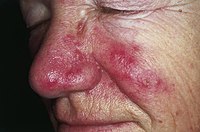
Photo from wikipedia
The purpose of this study is to evaluate the outcome of a series of patients with erythematotelangiectatic rosacea (ETR) affected by persistent erythema and varying degree of telangiectasias being treated… Click to show full abstract
The purpose of this study is to evaluate the outcome of a series of patients with erythematotelangiectatic rosacea (ETR) affected by persistent erythema and varying degree of telangiectasias being treated with brimonidine alone or combined with a vascular laser based on the type of vascular components preliminarily evaluated by clinical and instrumental observation. Ten patients affected by ETR were enrolled in a pilot, open study. Instrumental evaluation included erythema-directed digital photography by VISIA-CR™ system and X10 dermoscopy. Those patients showing marked background erythema and minimal telangiectasias (group A) were treated with a single application of brimonidine 0.33% gel, while patients showing both marked background erythema and marked telangiectasias (group B) were treated with a session of Nd:YAG laser and reevaluated 1 month later after a single application of brimonidine. An Investigator Global Assessment (IGA) of treatment outcome was performed at the end of treatment in both groups. In group A, 6 h after brimonidine application, a marked reduction of the background erythema was observed in all patients, and IGA was rated as excellent. In group B, 6 h following the application of brimonidine, a marked reduction of the background erythema was observed in all cases, while telangiectasias remained unchanged. A further treatment with brimonidine 1 month after the Nd:YAG laser session determined complete clearing of facial erythema, and IGA was rated as excellent. In conclusion, a preliminary evaluation of the vascular component by erythema-directed digital photography and dermoscopy in ETR may be helpful to select the most appropriate therapeutic strategy.
Journal Title: Lasers in Medical Science
Year Published: 2017
Link to full text (if available)
Share on Social Media: Sign Up to like & get
recommendations!